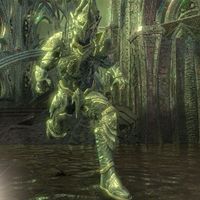| Tho'at Replicanum | |||
|---|---|---|---|
 Tho'at Replicanum the Glass Knight
Tho'at Replicanum the Glass Knight |
|||
| Race | Daedra Lord | Gender | Female |
| Resided in | Infinite Archive | ||
| Appears in | ESO | ||
- "Fate echoes unfavorably." —Tho'at Replicanum[1]
Tho'at Replicanum, also known as the Living Glass, the Glass Knight,[2] and She Who Became Vivified Ink,[3] is a Daedra Lord known for her invasion of the Infinite Archive in Apocrypha. She was overall an enigma, for how and even why she came to the Archive was unknown, except that she was in search for something.[3] One theory proposed by the keeper of the Infinite Archive, Master Malkhest, is that perhaps Tho'at has always been in the archive, though he quickly discarded that thought.[3] Though her origins were originally a mystery, what was initially known is that she transformed herself into a malleable being made entirely of ink.[4] It was later revealed that she is associated with the Daedric Prince Ithelia,[UOL 1] and Tho'at herself resembles the glass-like Daedra from the realm of Mirrormoor.[5][6]
The danger Tho'at poses is exemplified by her power of bringing myths from books into reality.[5] The books of the Infinite Archive offered a host of ink to work with, which Tho'at stripped off the books and coalesced it into black voids which dripped into floor[7] creating Maligraphies, Daedric creatures composed of vivified ink which are pieces of Tho'at without individuality. They were created from fragments of her nymic combined with the ink of the archive's tomes via Daedric magic.[5][3] These forms can include mortals of different races and affiliations, other daedric entities, animals, nature spirits, dragons, shades, celestials, undead, and even Dwemer or clockwork constructs. They can replicate not only the physical appearance of the forms they copy but also the accompanying equipment, including powerful artifacts.[8][9] Each maligraphy's strength depended on the page they were created from, translating the power in the contents of the page to physical prowess.[5] Due to the nature of the archive, a potentially infinite amount of maligraphies may have formed, though they are normally unable to sustain themselves outside of the archive,[5] some have found a way to escape it's confines.[10]
HistoryEdit
Circa around 2E 582, Tho'at made her presence known and attacked the Infinite Archive. Master Malkhest looked for outsiders to put a stop to her, recruiting through the connections of Gabrielle Benele[5] and utilizing seekers that scouted potential adventurers.[11] Tho'at's Malagraphies proved to be a challenge, so the adventurer or two that chose to participate in saving the Archive were aided by augmentations provided directly from Hermaeus Mora. The defeated maligraphies faded into puddles of ink.[5][3][8] In their confrontation with Tho'at Replicanum, Master Malkhest attempted to banish the Daedra Lord using her nymic, though before she was slain, she created Maligraphic copies of herself, replicating herself hundreds of times across the Infinite Archive. Though copies, the Tho'at replicas were considered entirely new entities and required the gathering a new nymic entirely. Thus, getting rid of Tho'at permanently required finding and banishing each and every copy of her by gathering the distinct Nymic of each.[3][12][13] At least one of her slayers of her copies was a member of the Undaunted, who took her sword as a trophy.[14] The daedra lord would continue evolving after every defeat and thus each encounter was harder than the last. The person that defeated the final evolution of Tho'at Replicanum was dubbed the "Inkslayer".[15]
Despite the final evolution's defeat, the Tho'at replicas and Maligraphies would continue to propagate through the Archive, and the Vestige and Malkhest would continue working to banish their spreading presence from the realm.[3][16][17]
GalleryEdit
NotesEdit
- Master Malkhest believes that, like many Daedra Lords, Tho'at Replicanum no doubt has a realm of her own somewhere in the infinite swirling void of Oblivion.[5]
ReferencesEdit
- ^ Tho'at Replicanum's dialogue in ESO: Necrom
- ^ Internal file names for Tho'at Replicanum
- ^ a b c d e f g Master Malkhest's dialogue in ESO: Necrom
- ^ Notes on Tho'at Replicanum — Malkhest
- ^ a b c d e f g h Loremaster's Archive - Infinite Archive — Master Malkhest
- ^ ESO 2024 Global Reveal
- ^ The Last Addition of Bikkus-Muz — Bikkus-Muz
- ^ a b Enemies in Infinite Archive in ESO
- ^ Boss List in Infinite Archive in ESO
- ^ Maligraphic Skeever and Maligraphic Mount in ESO
- ^ Aiding the Infinite Archive quest in ESO
- ^ The Margins of Ire quest in ESO
- ^ Replication Elimination quest in ESO
- ^ Trophy: Tho'at Replicanum Undaunted Trophy in ESO
- ^ Infinite Archive Conqueror achievement description in ESO
- ^ The Margins of Ire quest in ESO
- ^ Replication Elimination quest in ESO
Note: The following references are considered to be unofficial sources. They are included to round off this article and may not be authoritative or conclusive.
- ^ Youtube Stream of ESO's 10-Year Anniversary Celebration Livestream, time stamp 38:53-39:36